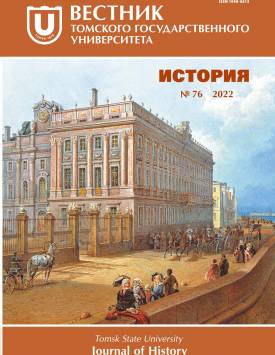Interethnic division of labor in the Yenisei province according to the census of 1897
The article deals with the interethnic division of labor in the Yenisei province. The author, based on the analysis of the data of the First All-Russian Population Census of 1897, shows that hunting and fishing were the main occupation of the indigenous inhabitants of the north of the province, nomadic cattle breeding was typical for the Turks of the south of the province, agriculture and industry were the main occupations of the incoming population - Russians and other immigrants from European Russia. The author seeks to prove that the interethnic division of labor was one of the main factors related to the peaceful annexation and development of Siberia, which made it possible to annex most of the territory of the Angara-Yenisei region without serious conflicts. The census shows that the interethnic division of labor persisted three centuries after the inclusion of the Yenisei lands into the imperial space. Newcomers were employed in all spheres of activity, most of all - in agriculture - 77734 (47.7%), in industry - 31580 (19.4%), in service -18126 (11.1%). 6457 (4.0%) lived off rent, 6134 (3.8%) were involved in trade, 5010 (3.1%) - in transport and communications, 3237 (2%) - in military service, 2374 (1.46%) - in management, 1898 (1.17 %) - in forestry, 1809 (1.1%) -worked in penitentiary institutions, 1606 (1%) - in fishing and hunting, 1384 (0.85%) - in animal husbandry, 1557 (0.83%) were engaged in education and medicine, 955 (0.59%) were ministers of religious cults, etc. The indigenous inhabitants of Siberia were mainly engaged in animal husbandry - 4225 (34%), agriculture - 3457 (27.8%), fishing and hunting - 2478 (20%), industry - 755 (6.1%), services - 639 (5.1%), lived off rent - 217 (1.7%), transport -68 (0.54%), trade - 59 (0.5%). Individual representatives of the indigenous peoples of Siberia were employed in some other branches of production, in management, in the sphere of culture. At the same time, the census data indicate serious consequences of the interaction of Russians and indigenous peoples in the economic sphere. Almost two-fifths of the Yenisei Turks (Khakas) became farmers switching from a nomadic lifestyle to a sedentary one. The ethnic identity recorded in the name of the estate "Siberian native tribes" did not always coincide with the class affiliation of the indigenous inhabitants of Siberia. The author marks their transition to the peasant class. By-products of peasants in terms of the number of employed began to surpass the number of indigenous people in their main areas of the economy - cattle breeding, hunting and fishing. The author believes that the Russian peasants were already a serious competitor to the indigenous inhabitants of Siberia in their main occupations.
Keywords
interethnic division of labor, economic development, Russians, indigenous inhabitantsAuthors
| Name | Organization | |
| Zinoviev Vasily P. | Tomsk State University; Tyumen State University | vpz@tsu.ru |
References

Interethnic division of labor in the Yenisei province according to the census of 1897 | Tomsk State University Journal of History. 2022. № 76. DOI: 10.17223/19988613/76/16
